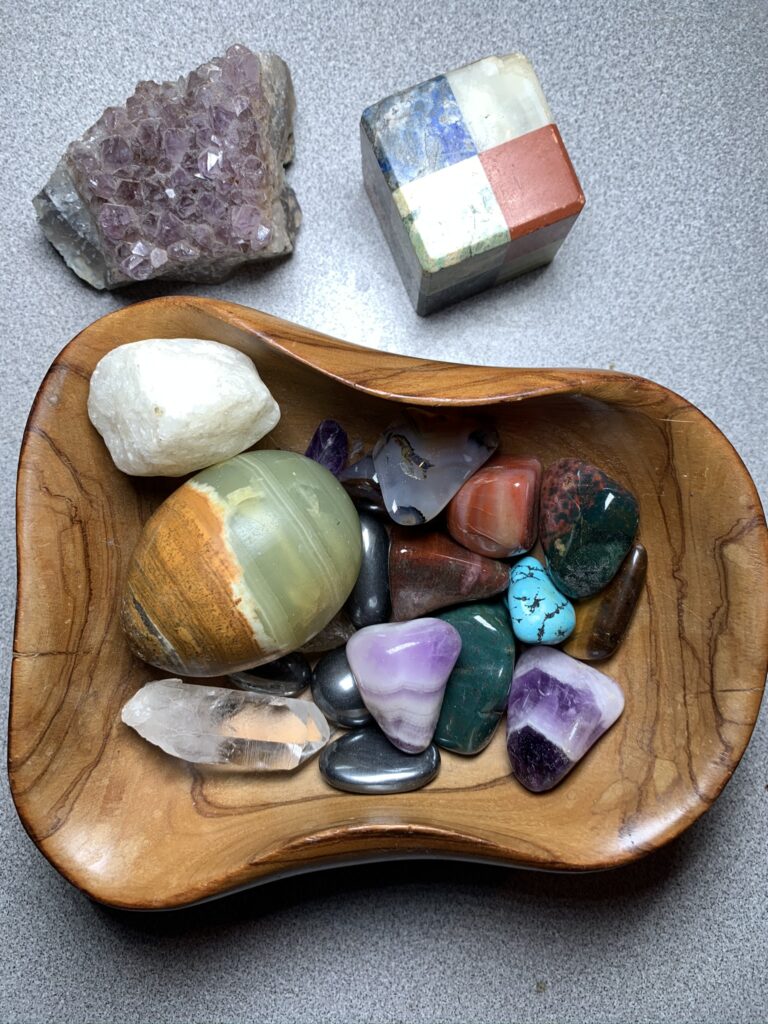
In a special space in my home, I keep a small collection of polished rocks. There are no more than eight or 10 of them. One is a crystal. Each landed in my hands from one source or another many years ago. One, the crystal actually, was given to me by a deeply spiritual and talented songwriter, who I had a brief musical encounter with one afternoon more than thirty years ago. Several were found among a loved one’s possessions after he died. The rest came from various other special moments, travels or experiences. Though I have lost track of the specific provenance of many of the rocks, the feelings evoked by the collection are rich and deep. I keep the collection in a special place in my basement, joyfully displayed in a strangely shaped little wooden bowl, an acquisition from one of many yard sales that has caught my impulse over the years.
When my oldest daughter was a little girl, she loved to play with my collection of rocks, and it brought me joy to share it with her. Somewhere along the line I noticed that although we shared a mutual appreciation for my little rock collection, we related to it in a very different way. For me it was the aggregate of having them all grouped together that made them so meaningful, a kind of collection of special moments reawakened. I don’t have a favorite. I love having them all together. I would be bummed if one went missing, because that would break up the whole. My daughter, on the other hand, seemed to focus on each one individually. She would study each one for its own qualities, carefully examining the shape, color and texture of each. She would then discard it and move on to the next. She appreciated each rock on its own basis. Each was its own experience.
This distinction in how different people relate to the world is an important thing to keep in mind when leading or working within a team. There are people who tend to see the big picture. They delight in weaving the strands together into a unified whole. For people like that – people like me – a funky wooden bowl can be as much a part of a rock collection as the rocks themselves. These people aren’t just aggregators, they are “synergizers.” They are excellent at keeping the big picture in mind, but they often need help staying on track with details. There are also precisionists. These people have a power to look incredibly deeply into each person, place, thing or situation and build for themselves a detailed sense of what it is and how it works. For these people, each piece of a puzzle is there to be carefully understood. These people are creators too. Their process is one of careful composition and construction. As long as they are helped to keep the ultimate objective in mind, they will produce high quality creations and deliver results.
Of course the story above is wildly oversimplified. Every human being has a wide array of unique qualities. This, incidentally, is my main complaint with the way various personality tests are frequently utilized in organizational management. I find several of these personality typographies to be incredibly helpful. My issue is not with the idea of personality tests so much as the way managers often misuse them. Mining personality tests to better understand and nurture people can be helpful. Using them to classify people invariably limits potential and deteriorates trust.
As leaders, a major part of our job is to help people with different tendencies, strengths and weaknesses learn to work together productively. To do this we need to create environments that value diversity. This does not mean anything goes, or that you cannot hold people accountable. To the contrary, clear expectations and straight talk are essential. But directness and kindness can live together authentically. When we strive to appreciate the individual gifts of each person we live and work with, when we place understanding above evaluation, we are well on our way to becoming effective leaders. And the teams we lead will be well on their way to accomplishing more together than any one member could ever have accomplished alone.



